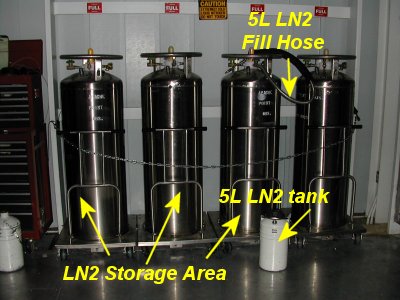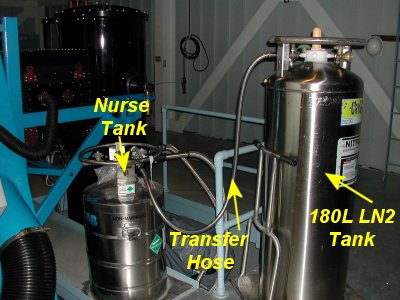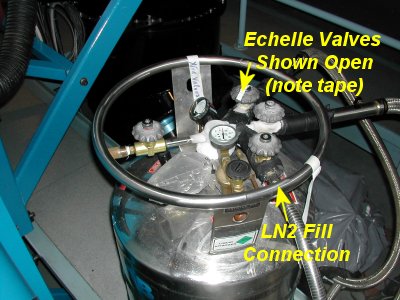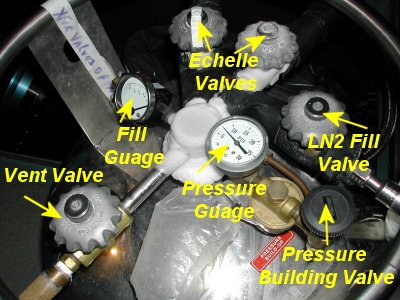
ARC 3.5m | Instrument Fills
Instrument Fill Log (pdf)
The light switches are located:
1) Tunnel entrance - on the wall to your left just as you enter the tunnel.
2) Lower level arcade - at the end of the tunnel under the 3.5m telescope.
3) Intermediate level - at the entrance to the stairs leading up to the 3.5m observing level.
4) 3.5m Observing level - at the top of the stairs on the wall to your right (leftmost switch controls the incandescent lights).

Echelle (Fill every 1.5 - 2 days, check level daily; fill when the digital scale drops below 230 lbs)
- Locate the 180L LN2 dewar on the wall by the Echelle, it should have the appropriate LN2 fill hose connected to it (with a quick disconnect fitting on one end) or nearby. Check the LN2 level on the tank; if it is less than 1/2 full you may run out of LN2 during the fill and have to change the hose to another tank. It will take approx 90L tank to fill the nurse tank when the Echelle tank is 3/8 full. You will also notice a change in pitch of the outflowing gas when the nurse tank runs out of LN2 during the middle of a fill. This is not a problem, just close all the valves and change the 180L nurse tank out with a fresh one.

- Roll the 180L LN2 dewar over to the Echelle but DO NOT connect the Liquid line to the fitting on the Echelle tank yet.
- Close the both LN2 fill valves (The ones on top of the nurse tank with the flat handles, order does not matter). Be sure to blot out any moisture on top of the valve body with a Kimwipe to prevent the valve from freezing, otherwise you may need to use a heat gun to un-freeze the valve in order to re-open it later. The picture below shows them as round handles valves, but these valves have been replaced with flat handle valves now.

- Open the LN2 Vent on the nurse tank for the Echelle (NOT the 180L Dewar).
- Make sure that the black pressure building valve is closed (fully CW).This knob has been removed due to leaking issues, and so you should not have to worry about this step.
- Make sure that the valve on the 180L dewar is ALREADY OPEN. Then connect the hose to the nurse tank, and open the nurse tank valve. The gas flowing out of the Echelle nurse tank vent should increase in rate if everything is connected properly, if not check to make sure the quick connect is seated properly and BOTH fill valves are open on each of the tanks.

- This operation takes about 20 mins., more or less, depending on how empty the Echelle tank is. Watch the weight on the digital scale mounted on the Echelle. (DO NOT tap on any guages with your fingers to make sure the needle doesn't stick).
- When the digital scale reaches 265 lbs, close the vent valve on the Echelle tank to start building pressure in the Echelle tank, it will take 3-5 mins to build pressure. Tap on the guage to make sure the needle doesn't stick.
- Let the nurse pressure build until it reaches around 7 PSI. Keep watch on the digital scale, and DO NOT let it reach 300 lbs. Close the Echelle fill valve (and NOT the 180L LN2 tank liquid valve) and disconnect the quick connect fitting. You may also use the ALTERNATIVE method for pressurizing the nurse tank below, if absolutely necessary.
- IMPORTANT! OPEN the 2 LN2 fill valves for the Echelle (THIS IS VERY IMPORTANT!)
- Check that the following Echelle valves are in the following state:
Vent relief Valve - Closed
Pressure Building valve (Black knob) - Closed
LN2 Fill Valve - Closed
LN2 Echelle Feed Valves (2 valves with flat handles) - OPEN!
- Roll and secure the 180L storage dewar back where you found it, update the sign on the wall so that it shows how much LN2 is left in the 180L dewar.
- Fill out the LN2 fill log sheet on the side of the storage cabinet where LN2 saftey equipment lives & update the white status board in the Ops building.
(ALTERNATIVE method for pressurizing the nurse tank) This method should only be used with premission from Bill Ketzeback, as the black knob has been REMOVED for leaking purposes.
- Close the vent valve then close the Echelle LN2 fill valve. Disconnect the quick connect fitting.
- Now open the pressure building valve (black valve knob on the nurse tank).
- Once 7 PSI is reached (5-10 mins) in the nurse tank, fully close the pressure building valve (Be sure to close the valve or all the LN2 will bleed away in about a day).
- IMPORTANT! OPEN the 2 LN2 fill valves for the Echelle (THIS IS VERY IMPORTANT!)
- Check that the following Echelle valves are in the following state:
Vent relief Valve - Closed
Pressure Building valve (Black knob) - Closed
LN2 Fill Valve - Closed
LN2 Echelle Feed Valves (2 valves with flat handles) - OPEN!!!
- Roll and secure the 180L storage dewar back where you found it, update the sign on the wall so that is shows how much LN2 is left in the 180L dewar.
- Fill out the LN2 fill log sheet on the side of the storage cabinet where LN2 saftey equipment lives & update the white status board in the Ops building.
NIC-FPS (2x per day)
- Remove brass bolt from fill port on back of NIC-FPS.
- Purge the LN2 fill line with LN2 by opening the liquid valve until LN2 starts flowing out. Be sure to keep the end of the stinger in a safe direction.
- Insert "stinger" on the LN2 nurse tank all the way into fill port (you may need to push LN2 nurse tank up to keep stinger in when filling, the back pressure tends to blow the stinger out).
- Open LN2 fill valve to start filling NIC-FPS, fill until LN2 comes out of port.
- Close LN2 fill valve, remove stinger, and install brass bolt back into the end of NIC-FPS.
- Fill out the LN2 fill log sheet on the side of the storage cabinet where LN2 saftey equipment lives & update the white status board in the Ops building.
TSPEC (every afternoon)
Main tank
- Remove brass cap from the bottom fill port on bottom of TSPEC (It is the most forward cap between the two aluminum spash shields). FILL TSPEC with the ports in the downward position only!
- Insert the LN2 fill hose from the front end under the instrument and insert the stinger into the fill port and secure with the threaded brass nut (DO NOT pre-cool/purge the line).
- Open the valve on the 180L LN2 tank and exhaust gas should start venting out of the copper tube at the rear of TSPEC.
- When liquid starts coming out of the vent tube, close off the 180L LN2 fill valve. Wait a minute or two for excess LN2 in the fill line to purge then remove the fill line. Be carefull of LN2 on the floor (kneeling in a puddle of LN2) and LN2 coming out of the fill line on your hands (Use LN2 gloves). DO NOT use excessive force on removing the fill line nut if frozen on (carefully use a heat gun to defrost instead).
- Replace the brass cap on the bottom fill port. Leave the cap on loosely (about 1/8 turn from tight).
- Put the 180L dewar back.
- Fill out the LN2 fill log sheet on the side of the storage cabinet where LN2 saftey equipment lives & update the white status board in the Ops building.
Aux tank (every Monday afternoon)
- Rotate the instrument so the ports are facing upward.
- Remove brass cap from the rear-most fill port of TSPEC.
- Insert funnel into port.
- Fill funnel with LN2.
- LN2 will come out of port when full.
- Remove funnel, replace cap, and rotate instrument back to the downward position.
GIFS (Check status board to see if we are currently filling this instrument. If yes, then 2x per day)
- The dewar and hose should already be connected to the 180L dewar.
- The 180L dewar valve should ALREADY BE OPEN. If not, slowly open the 180L dewar valve about half a turn.
- Connect the hose to the port on GIFS. You should start to hear venting out of the mushroom cap.
- When liquid starts flowing out of the mushroom head on top of the fill hose attachment, the instrument is full. Disconnect the quick connect hose from GIFS while leaving the 180L valve OPEN.
- Leave the 180L dewar where it is against the wall.
- Fill out the LN2 fill log sheet on the side of the storage cabinet where LN2 saftey equipment lives & update the white status board in the Ops building.